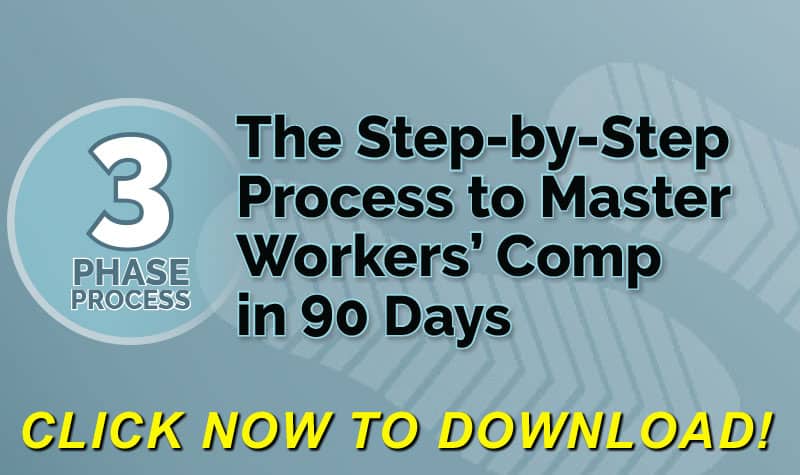
Let’s begin by addressing common pitfalls and then delve into the foundational phase—building the framework for success.
As we start 2025, the Framework and Goals step is critical to define.
Common Errors When Getting Started
Misidentifying the Problem
A common error when reforming a workers’ compensation program is misidentifying the root cause of challenges. Many employers point fingers at their injury management partners, assuming they are the primary issue. Examples of this misidentification include:
- “We have a ton of adjuster turnover.”
- “I asked for surveillance on that claim, and they refused.”
- “The treating physicians never release employees back to work.”
- “We’re paying exorbitant fees for nurse case management.”
While these issues are valid concerns, they often overlook the bigger picture. Injury management partners can only be as effective as the employer’s level of engagement and activity in the program.
Click Link to Access Free PDF Download
Overwhelm of Opportunity
The second major obstacle is the overwhelm caused by too many areas for improvement. Workers’ compensation programs are multifaceted, and leaders often struggle to prioritize. Common complaints include:
- “Our return-to-work program is non-existent.”
- “Supervisors need better training.”
- “Communication with physicians needs improvement.”
- “Old claims need resolution.”
Without a clear roadmap, this overwhelming landscape leads to inaction or scattered, ineffective efforts. The solution? A step-by-step process that tackles these challenges in a deliberate sequence.
Phase 1: Framework
Reducing workers’ compensation costs is not a goal—it’s an outcome. The true goal is to establish a well-structured program that minimizes claims, expedites recovery, and ensures injured workers return to work promptly. The first phase is to develop a framework by assessing your current program, identifying gaps, and establishing clear goals.
Step 1: Establish Your Program Goals
A lack of clear vision and goals often results in mediocre outcomes. In workers’ compensation, mediocrity translates to:
- High costs
- Elevated litigation rates
- Frustration and stress
- Lack of control over processes
- Time wasted chasing malingering employees or arguing with medical providers
- Persistent turnover among adjusters
- Pressure from upper management without clear solutions
In contrast, a Best-In-Class program offers:
- Lower costs and litigation rates
- Confidence and satisfaction
- Control over outcomes
- Positive feedback from employees and their families
- Collaborative relationships with medical providers and adjusters
- Recognition as a valued leader within the organization
- Financial rewards for program success
- Opportunities to win risk management awards
To achieve these results, you must articulate your vision and motivations. Reflect on these key questions:
- What are the most critical goals for the next 12 months?
Identify your main priorities and where your team’s efforts should focus. - Imagine your ideal program one year from now:
- What does it look like at your company?
- How does it feel for you and your employees?
- What has it done for your career and your partnerships?
- What financial metrics will you proudly present to upper management?
- What are your goals for six months, one year, and five years?
FREE DOWNLOAD: “Step-By-Step Process To Master Workers’ Comp In 90 Days”
A Deeper Look at Goals
While financial metrics are an easy motivator, they are often insufficient for sustainable change. Surface-level goals, like cost reduction alone, can lead to short-term wins but fail to address deeper organizational habits. A fitting analogy is weight loss: fad diets may result in rapid progress, but without long-term lifestyle changes, old habits quickly return.
To build a resilient and successful workers’ compensation program, you need goals that go beyond numbers. These goals should encompass cultural change, better employee relationships, and recognition for your leadership in driving results.
Laying the Foundation for Long-Term Success
The first phase—Framework—is critical. By assessing your current program, setting clear priorities, and articulating a compelling vision, you pave the way for success. Subsequent phases, focusing on employer controls and external controls, build on this foundation, ensuring every aspect of the program aligns with your goals.
A well-structured framework transforms workers’ compensation from a source of frustration into an area of strength and pride. As you continue on this journey, remember that success is not about quick fixes but about creating lasting, meaningful change that benefits your employees, your organization, and your career.

Contact: mstack@reduceyourworkerscomp.com.
Workers’ Comp Roundup Blog: http://blog.reduceyourworkerscomp.com/
Injury Management Results (IMR) Software: https://imrsoftware.com/
©2024 Amaxx LLC. All rights reserved under International Copyright Law.
Do not use this information without independent verification. All state laws vary. You should consult with your insurance broker, attorney, or qualified professional.
FREE DOWNLOAD: “Step-By-Step Process To Master Workers’ Comp In 90 Days”








